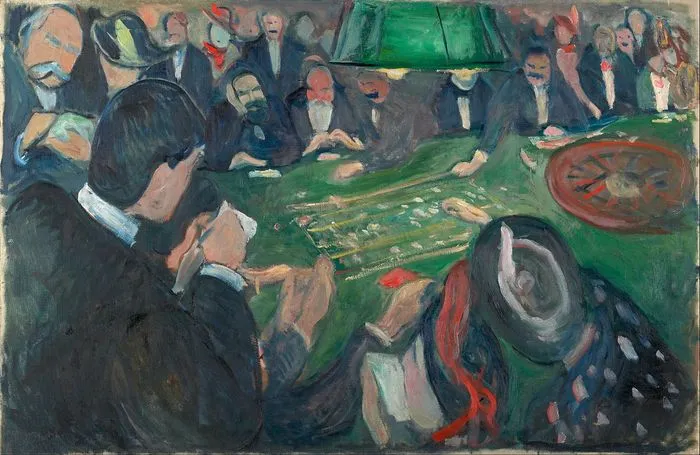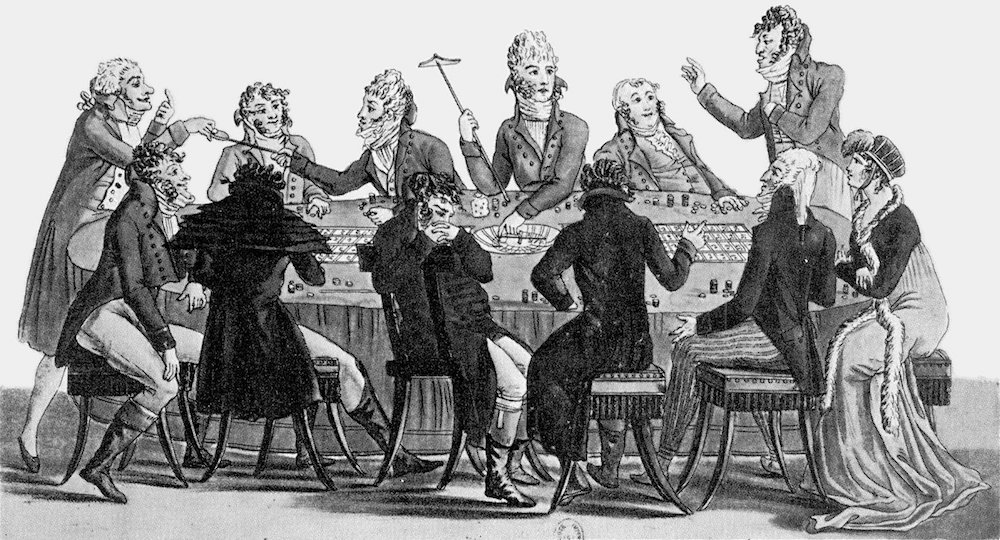Gambling is part of recreational culture, and therefore is rarely associated with true art. But this simplistic view overlooks the creation of iconic literary, cinematic and pictorial objects inspired by gambling culture.
The statement that gambling and art go hand in hand is probably reckless, but to ignore the fact that artists have used gambling in their work over the years is also wrong. Some of the paintings have even managed to gain fame, recognition, and bring their creators well-deserved monetary rewards.
In the age of online gambling, it’s easy to forget the ancient roots of gambling and how closely and long it has accompanied human culture. The homeland of these entertainments, which ironically has abandoned them, is considered to be China. One way or another, gambling has spread all over the world. And though in the beginning of its way and were the fun for the rich, then turned into a mass entertainment. It is believed that this turning point came in the middle of the 15th century.
We decided to trace how in the history of fine art appeared and consolidated objects, the subjects of which were gambling.

Michelangelo Merisi da Caravaggio’s “The Cardsharps”
The painting “The Cardsharps” belongs to the brush of the famous Italian artist Caravaggio. Painted in 1594, it was one of the artist’s first independent efforts, which he undertook after leaving the studio of Giuseppe Cesari. Caravaggio stopped painting the details of other people’s works and began to sell his own canvases through the merchant Constantino, whose acquaintance he owed to Prospero Orsi.
Composition
The canvas depicts a young man whose expensive clothes contrast sharply with the childlike naivety captured by the artist on his face. In the scene, the young man is playing cards with a cheat. The viewer can guess the trade of the latter from the cards hidden behind his belt. The painting also shows the sinister swindler’s assistant, who peeks diligently at the young man’s cards and, with the help of special gestures, conveys information to the swindler. Dramatic in this picture is the imposing dagger fastened to the assistant’s belt, as if to hint to the viewer that the game is unlikely to end well for the victim.
Interesting
More than 50 copies and various variations of the painting have been preserved. All of them were created by other artists. One of them was Georges de Latour, who also decided to create his own treatment of the subject.
It should be noted that the realistic composition of Cheaters, which was the embodiment of street life, was a breath of fresh air in the then world of painting. It drew attention to the skills of the budding artist.
The painting was a great success, to which Orsi greatly contributed. The latter also proclaimed the emergence of a new style, which in every way contributed to strengthening the reputation of Caravaggio.
Georges de La Tour “The Cheat with the Ace of Clubs”
The following painting has been called one of the greatest masterpieces of 17th-century French art. Georges de la Tour tried to use his brush to depict the dangers of indulging in human weaknesses – alcoholic beverages, fornication and gambling. It is believed that the work of Caravaggio we reviewed served as the inspiration for a reconsideration of gambling themes.
Interesting
Another autograph version of the painting “Deception with the Ace of Diamonds” shows numerous variations in the details of the composition – clothing and accessories.
In front of the viewer is a young man surrounded by three ladies, the emphasis is on the riot of colors and the incredible beauty of the characters’ costumes. Only two women take part in the game, the third is a maid. There is wine in the glasses and playing cards in the hands. The participants in the action communicate with one another with their eyes, and the young man unwraps the cards so that the spectator can see their face value, as if inadvertently making him an accomplice in the scheme. At the same time he reaches with his other hand for the ace of clubs, which he had been thoughtfully hiding in his waistband.
Jan Steen “Argument over a Card Game”
In an attempt to sell the painting, its name has changed several times. Known variants are “Argument over a card game”, as well as “Argument at the card table”.
Jan Sten – Dutch master of the genre, who tried to bring in their works instructive, which at times was more like a moralizing. The characters depicted by the artist testify to the irony of the author.
The dramatic scene from everyday life showed the drama and exuberance of emotions accompanying gambling.
Composition
In front of the viewer is an intricate scene with many characters placed by the artist in the foreground and background. Given that Sten liked to resort to social satire, even a child and a dog take part in the bacchanalia. The table on which backgammon used to stand is now empty, and all the items necessary for gambling are scattered on the ground, as is the carafe of wine. The main characters – representatives of different estates, which is clear if you look closely at the clothes and accessories of each – threaten each other with different types of knives. The one who belongs to the privileged class grabs his saber, and his gambling partner pulls out a knife. The rest of the characters in the picture try to prevent the fight.
Even the background and its participants are extremely important: their facial expressions convey the atmosphere, some are drunk, some are laughing, and there are those who are seriously frightened.
Cezanne “The Card Players”
There are five versions of the series, each different in size and content. One is in a private collection and the others are in museums. In 2011, the private version was purchased by the royal family of Qatar.
The Card Players, or “Card Players,” is not a single work, but an entire series of paintings by the French post-impressionist Paul Cézanne. Moreover, the ambitious project is seen as a significant contribution to contemporary art. The paintings took several years to complete. Despite the fact that they were painted during one of the last periods of the artist’s work, some of them are considered classics of the French school.
Cézanne is known for his still life painting, art historians believe that he chose the theme of gambling because at the time gamblers were a form of human still life.
Composition and Analysis
Each painting in the series depicts two or more Provençal peasants, peacefully smoking their pipes, at a card game. Cézanne modeled the peasants after the workers on his own family estate.
Unlike the drunken, boisterous peasants depicted in the paintings of the Dutch realistic school of genre painting, Cézanne’s peasants are wholly absorbed in the game. As a rule, all the characters in the series are depicted in silence. There is no excitement or drama depicted in the paintings; on the contrary, Cézanne’s canvases give a sense of serene tranquility. Art historian Roger Fry, who has studied Post-Impressionism, has described the Cartwrights as having an extraordinary sense of monumental gravity, finding their center and therefore under no circumstances subject to displacement.
Cassius Marcellus Coolidge “Dogs Playing Poker”
Next we will talk not about one painting, but about an entire series of works by Cassius Coolidge. In total, the series is represented by 18 paintings. The original painting was called “Playing Poker”, the work was completed in 1894, another 16 works were commissioned in 1903 to advertise cigars. The last painting in the series was completed in 1910. All 18 paintings contain images of dogs with human features, but only 11 have elements of gambling.
At the same time, despite the fact that the series was popular, it also came under criticism, which, among other things, had the nature of personal insults against the author of the paintings.
Interesting
Coolidge’s first painting, Poker Game, sold five years ago at a Sotheby’s auction in New York for $658,000.
Be that as it may, the dogs with expressive emotions on their faces playing poker, as well as the corresponding entourage of smoking pipes and whiskey glasses, became iconic. References to the picture began to be heard in popular television shows. The work has been copied and parodied countless times. The characters even became popular kitsch motifs – they were depicted on T-shirts, coffee mugs, and home decor items.
Note that Coolidge is considered an iconic artist, especially in the world of popular culture. He is sometimes ironically referred to as “the most famous American artist no one has ever heard of.
It is not known exactly what inspired the painting. Despite this, art historians believe that the composition of the image is a reference to the works of Caravaggio and Cézanne. In Coolidge, however, the peasants are replaced by dogs.
Composition
In essence, the series of paintings is a narrative of one story. In “Bold Bluff,” the Saint Bernard bets a pair of twos, leaving his opponents to decide whether or not he is bluffing. In the next picture in the series, the opponents growl at the paw of the Saint Bernard, diligently raking what he has won into a big pot.
One of the most popular paintings in the series was “Friend in Need.” In the story, the bulldog in the foreground slips an ace to his partner while his competitors absent-mindedly stare into the table. Particular attention is drawn to the emotion reflected in the muzzle, a playful depiction of deception. This painting has never been sold, but is estimated to be worth several million dollars.

Fernand Leger “Soldiers Playing at Cards”
The French painter Fernand Léger was fascinated by Impressionism long before he turned to abstract art. From 1910 his paintings began to contain some features of Cubism, such as a monochrome palette, the decoration of objects and the presence of geometric figures.
Léger’s painting Soldiers Playing Cards, sometimes referred to as The Card Party or The Card Players, is considered a symbol of the transition to a “mechanical” period in the artist’s work. The painting was painted after his hospitalization in Paris. During the battle of Verdun he was gassed. The painting remains one of the artist’s best works on military themes.
It reflects the deep affinity that existed between the artist and his army brothers and is not without a certain tragedy, which nevertheless is not conspicuous.
Composition
The drawing shows three soldiers seated at a card game. The most prominent of the soldiers wears a medal on his chest and his head is crowned with the traditional red hat worn by soldiers in the French army.
The second player, shown in the center, judging by the stripes on his uniform, is a sergeant, holding cards in his left hand and smoking a pipe. The third gambler, on the other hand, is drawn in darker colors and has a helmet on his head instead of a cap. The smoke he blows has a geometric shape.
All three men depicted in the painting seem to be taken apart, like car parts. It is believed that in this way the artist tried to emphasize the mechanical nature of trench warfare and the anonymity of its participants. Although the artist’s comrades can be identified by minor details, on the whole they are devoid of any human feeling. The palette of gray that dominates the work and the lack of emotion have defined this work. Thus, the painting is considered a powerful but demonstrative critique of the aftermath of war.
